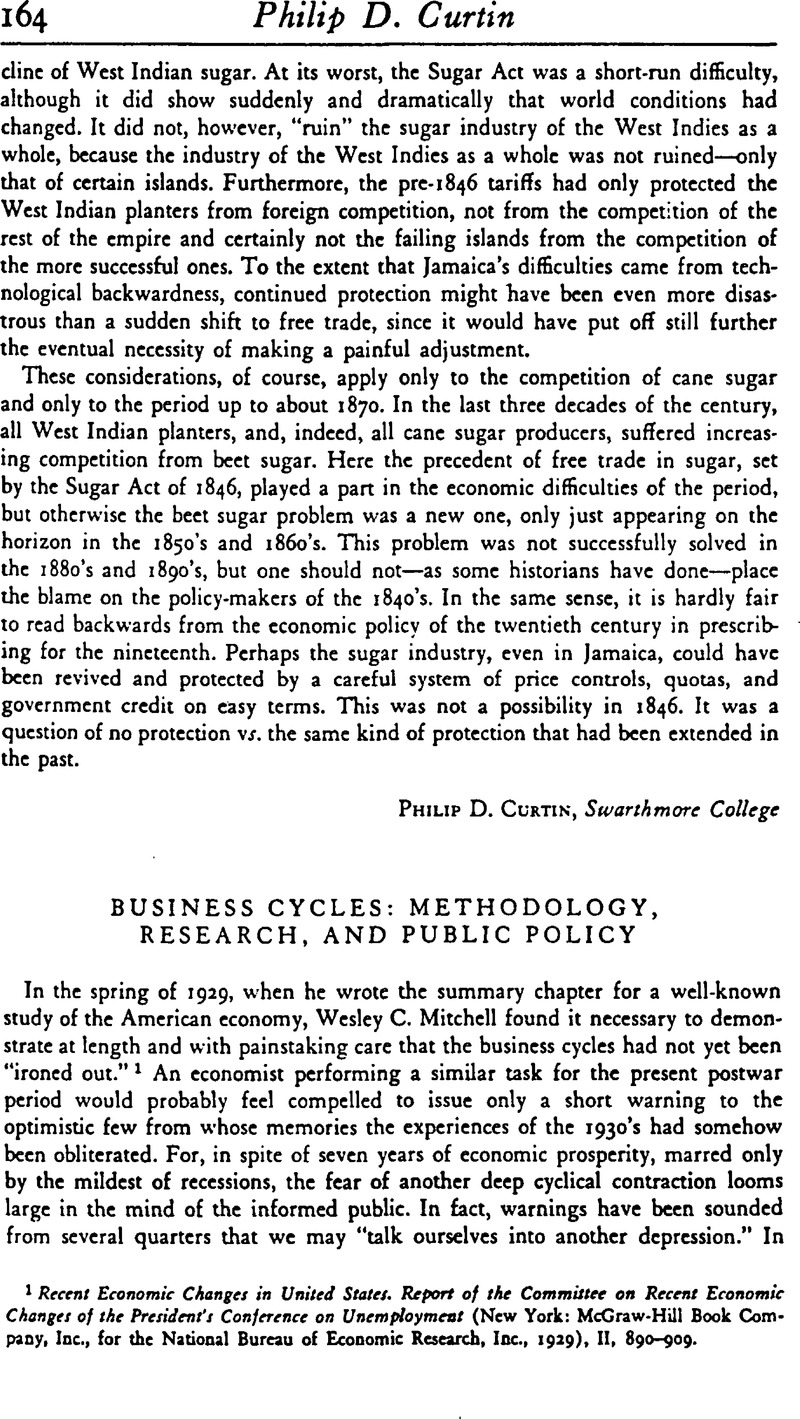Article contents
Business Cycles: Methodology, Research, and Public Policy
Published online by Cambridge University Press: 03 February 2011
Abstract

- Type
- Notes and Review Article
- Information
- Copyright
- Copyright © The Economic History Association 1954
References
1 Recent Economic Changes in United States. Report of the Committee on Recent Economic Changes of the President's Conference on Unemployment (New York: McGraw-Hill Book Company, Inc., for the National Bureau of Economic Research, Inc., 1929), II, 890–909.Google Scholar
2 Conference on Business Cycles (“Special Conference Series 2” [New York: National Bureau of Economic Research, Inc., 1951]), pp. xii, 433. $6.00. Two of the manuscripts presented at the conference, What Happens During Business Cycles by Mitchell, Wesley C. and Inventories and Business Cycles by Abramowitz, Moses were published separately by the National Bureau in 1950 and were reviewed in The Jouinai. of Economic History, XII, No. 3 (Summer 1952), 270–76Google Scholar.
3 See Klein, Lawrence R., Economic Fluctuations in the United States, 1921–1941 (Cowles Commission for Research in Economics, Monograph No. 11 [New York: John Wiley and Sons, 1950]Google Scholar). Reviewed in The Jouknal of Economic History, XII, No. 3 (Summer 1952), 291–92Google Scholar.
4 E.g., Davis, Tom E., “The Consumption Function as a Tool for Prediction,” Review of Economics and Statistics, XXXIV, No. 3 (08 1952), 370–77Google Scholar.
5 The term “consumption function,” as employed by Schumpeter, refers to levels and standards of consumption that are altered by economic innovations rather than to the Keynesian schedule relating aggregate consumption to aggregate income.
6 Business Cycles. A Theoretical, Historical and Statistical Analysis of the Capitalist Process (New York: McGraw-Hill Book Company, Inc., 1939), I, 170–71.Google Scholar
7 For a full statement of Gordon's, Mr. position, see “Business Cycles in the Interwar Period: The Quantitative-Historical Approach,” American Economic Review, XXXIX, No. 3 (05 1949. 47–3Google Scholar.
8 Distributions of cyclical turning points, similar to those used by Mr. Wright, are graphically presented in Geoffrey Moore, H., Statistical Indicators of Cyclical Revivals and Recessions (“Occasional Paper 31” [New York: National Bureau of Economic Research, Inc., 1950]), Chart 3, pp. 14–17Google Scholar.
9 Bums, Arthur F., “Keynesian Economics Once Again,” The Review of Economic Statistics, XXIX, No. 4 (11 1947), p. 261.Google Scholar
10 Burns, Arthur F., The Instability of Consumer Spending (“Thirty Second Annual Report of the National Bureau of Economic Research, Inc.” [New York: National Bureau of Economic Research, Inc., 05 1952]), pp. 87.Google Scholar
11 Dobrovolsky, Sergei P., Corporate Income Retention, 1915–1943 (“Studies in Business Financing” [New York: National Bureau of Economic Research, Inc., 1951]), pp. xviii, 112. $2.50.Google Scholar
12 For the preliminary report of an investigation that has yielded different results, see Lintner, John, “The Determinants of Corporate Savings,” in Heller, Walter W., Boddy, Francis M., and Nelson, Carl L., eds., Savings in the American Economy (Minneapolis: The University of Minnesota Press, 1953), pp. 230–58Google Scholar.
13 Hansen, Alvin H., Business Cycles and National Income (New York: W. W. Norton and Company, 1951), pp. xv, 639. $7.25.Google Scholar
14 Frickey, Edwin, Production in the United States, 1860–1914 (Cambridge: Harvard University Press, 1947), pp. 54, 64.Google Scholar
15 Mr. Hansen does not list this fluctuation in his catalogue of major cycles.
16 For a careful evaluation of Federal Reserve Board index during most of the period of war production, see Moore, Geoffrey H., Production of Industrial Materials in World Wars I and II (“Occasional Paper 18” [New York: National Bureau of Economic Research, Inc., 03 1944], Pan IVGoogle Scholar.
17 See Friedman, Milton, “Wesley C Mitchell as an Economic Theorist,” The Journal of Political Economy, LVI1I, No. 6 (12 1950), pp. 465–93CrossRefGoogle Scholar.
18 Egle, Walter P., Economic Stabilization. Objectives, Rules, and Mcchanisms (Princeton: Princeton University Press, for the University of Cincinnati, 1952), pp. xii, 264. $4.00.CrossRefGoogle Scholar
19 Maxwell, James A., Federal Grants and the Business Cycle (“Fiscal Studies 4” [New YorkNational Bureau of Economic Research, Inc., 1952]), pp. xi, 122. $2.00.Google Scholar
20 Mitchell, Wesley C., “National Unity and Individual Liberties,” School and Society (06 13, 1942)Google Scholar, quoted in Mitchell, Lucy Sprague, Two Lives. The Story of Wesley Clair Mitchell and Myself (New York: Simon and Schuster, 1953), p. 404Google Scholar.
- 1
- Cited by




